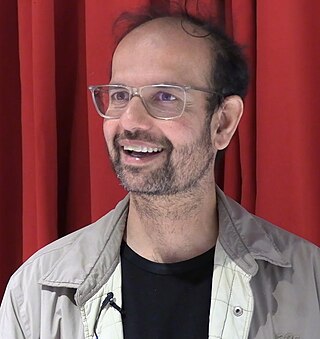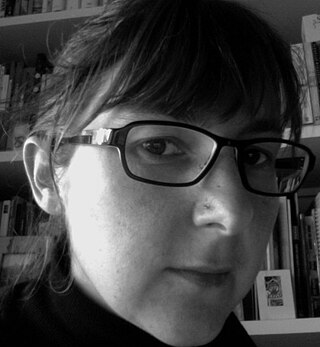
Performance art is an artwork or art exhibition created through actions executed by the artist or other participants. It may be witnessed live or through documentation, spontaneously developed or written, and is traditionally presented to a public in a fine art context in an interdisciplinary mode. Also known as artistic action, it has been developed through the years as a genre of its own in which art is presented live. It had an important and fundamental role in 20th century avant-garde art.

Marina Abramović is a Serbian conceptual and performance artist. Her work explores body art, endurance art, the relationship between the performer and audience, the limits of the body, and the possibilities of the mind. Being active for over four decades, Abramović refers to herself as the "grandmother of performance art". She pioneered a new notion of identity by bringing in the participation of observers, focusing on "confronting pain, blood, and physical limits of the body". In 2007, she founded the Marina Abramović Institute (MAI), a non-profit foundation for performance art.

Arts Commons is a multi-venue arts centre in downtown Calgary, Alberta, Canada, located in the Olympic Plaza Cultural District.

Janet Cardiff is a Canadian artist who works chiefly with sound and sound installations, often in collaboration with her husband and partner George Bures Miller. Cardiff first gained international recognition in the art world for her audio walks in 1995. She lives and works in British Columbia, Canada.

Louise Lawler is a U.S. artist and photographer living in Brooklyn, New York City. Lawler’s work has focused on photographing portraits of other artists’ work, giving special attention to the spaces in which they are placed and methods used to make them. Examples of Lawler's photographs include images of paintings hanging on the walls of a museum, paintings on the walls of an art collector's opulent home, artwork in the process of being installed in a gallery, and sculptures in a gallery being viewed by spectators.

Ann Hamilton is an American visual artist who emerged in the early 1980s known for her large-scale multimedia installations. After receiving her BFA in textile design from the University of Kansas in 1979, she lived in Banff, Alberta, and Montreal, Quebec, Canada before deciding to pursue an MFA in sculpture at Yale in 1983. From 1985 to 1991, she taught on the faculty of the University of California at Santa Barbara. Since 2001, Hamilton has served on the faculty of the Department of Art at the Ohio State University. She was appointed a Distinguished University Professor in 2011.

Tino Sehgal is an artist of German and Indian descent, based in Berlin, who describes his work as "constructed situations". He is also thought of as a choreographer who makes dance for the museum setting.

Adelle Lutz is an American artist, designer and actress, most known for work using unconventional materials and strategies to explore clothing as a communicative medium. She first gained attention for the surreal "Urban Camouflage" costumes featured in David Byrne's film True Stories (1986).

Hamish Fulton is an English walking artist. Since 1972 he has only made works based on the experience of walks. He translates his walks into a variety of media, including photography, illustrations, and wall texts. His work is contained in major museums' collections, such as the Tate Britain and MoMA. Since 1994 he has been creating group walks for the public. Fulton argues that "walking is an artform in its own right" and argues for wider acknowledgement of walking art.
Deveron Projects, formerly Deveron Arts, is a United Kingdom arts organisation based in Huntly, Aberdeenshire, Scotland that hosts international artists from a variety of disciplines to collaborate with the town community. Deveron Projects follows a '50/50' approach, which gives equal attention to impact on the local community and impact on the international art scene. Residencies have been provided to artists from China, the Americas, India, Africa and mainland Europe as well as North East Scotland.
Clare Twomey is a London-based visual artist, curator and researcher, working in performance, serial production, and site-specific installation. Her practice encompasses site-specific installation and performance; she frequently collaborates with institutions, enouraging participation and temporality.
Simone Kenyon is a performer, artist and producer born in Bradford, West Yorkshire. She works extensively with walking, and in collaboration with other artists and dancers. In 2006, with the dancer Tamara Ashley, she made 'The Pennine Way: The Legs that Make Us', a durational art project in the form of a walk, creating a performance lecture about the project for ROAM a weekend of walking at Loughborough University in 2008, and a book published by Brief Magnetics in 2007. With Andrew Brown and Katie Doubleday she instigated the 'Open City' project in 2006, exploring the organisation and control of behaviour in the public realm. Kenyon worked with Deveron Arts in Huntly, Aberdeenshire on the founding of their "Walking Institute" and completed a commission 'Hielan' Ways' - a long distance walk in the Cairngorms in 2013-14. She has also completed walking-based work Step by Step, 2013 for Dance4 in collaboration with Neil Callaghan. Kenyon is connected with the Walking Artists Network.

Clare Qualmann is a British multi-media performance artist based in London, UK. She is a senior lecturer in performing arts at the University of East London and also teaches at London Metropolitan University.
The Walking Artists Network (WAN) is an international network dedicated to walking as a critical and artistic practice. It reflects an increased interest in walking art and the growth of the field. Based at the University of East London, it has over 700 members from across the globe. The network maintains an active email discussion community through JISCmail.
Wrights & Sites is a group of British artists who work with site-specific performance and walking art. Founded in 1997, Wrights & Sites consists of artist researchers Stephen Hodge, Simon Persighetti, Phil Smith and Cathy Turner. Their work is inspired by the Letterist and Situationist Internationals, particularly the practice of dérive.
Cathy Turner is a British artist and researcher, specialising in dramaturgy, site-specific performance and walking art. She is a founder member of Wrights & Sites, and a Senior Lecturer in Drama at the University of Exeter. Turner's practice and research explore how one's life experience can influence one's perception of their environment.

Marjorie Schick was an innovative American jewelry artist and academic who taught art for 50 years. Approaching sculptural creations, her avant-garde pieces have been widely collected. Her works form part of the permanent collections of many of the world's leading art museums, including the Hermitage Museum in Saint Petersburg, Russia; the Museum of Arts and Design in New York City; the National Museum of Modern Art in Kyoto, Japan; the Philadelphia Museum of Art in Pennsylvania; and the Victoria and Albert Museum of London.
Sylvia Palacios Whitman is a Chilean-American artist, painter, sculptor, and performer.
Justine A. Chambers is a dancer, choreographer and artist currently living and working in Vancouver, British Columbia. Interested in social choreographies of the everyday, she engages dance in site-specific, experimental and collaborative creation.
Walking art refers to a variety of artistic practices that position walking as the central process, experience or outcome. Walking artists have diverse interests and it 'has gathered practitioners from nearly every field'.:43 Despite emerging from a variety of artistic and literary traditions, a 'common feature [of walking art] is the engagement of the body in a process of walking through a landscape based on a specific artistic design.':161 Some artists consider walking an artistic end in itself, while others use walking as a means of mark-making, storytelling, social practice, or to create work in other artistic media.











